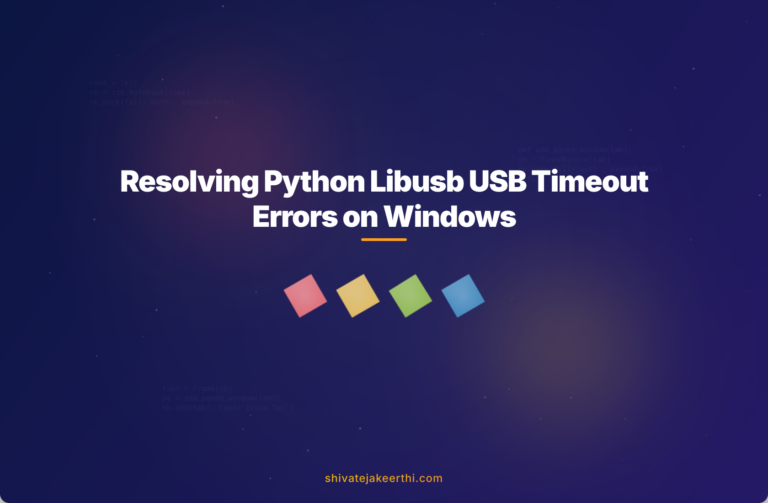Many developers use Python along with the popular library Libusb to communicate with USB devices on Windows. However, encountering a USB timeout error can be frustrating, interrupting workflows and hindering reliable data transfer. Resolving this error quickly can make your development process smoother and prevent unnecessary headaches.
What Is a USB Timeout Error?
When your Python program communicates with a USB device using Libusb, it expects responses within certain time limits called timeouts. If a response takes too long, the computer halts communication and triggers a timeout error.
Common causes of a USB timeout error typically include slow or inefficient communication, incorrect timeout settings in your code, or hardware-related issues like faulty cables or outdated drivers.
Slow communication often occurs when data processing on the device side cannot keep pace with the requests made by the computer. On the other hand, incorrect timeout settings in the Python code might cause the system to prematurely classify communication as delayed. Hardware issues—such as outdated USB drivers, loose cables, or faulty devices—can also contribute significantly to this error.
Troubleshooting USB Timeout Error in Python with Libusb
Before diving into complex solutions, start simple: Check your Python code. Python scripts interacting with hardware can often reveal small overlooked mistakes.
Take a pause and carefully review your Python code, verifying every argument passed into Libusb functions. Often, small mistakes, like incorrect parameters or missing loops, lead to big issues later.
Also, ensure you’re using the most recent version of Libusb. Developers often fix known timeout issues in new releases. Staying up-to-date can prevent unnecessary troubleshooting. Visit Libusb’s official website or their GitHub repository to get the latest stable version.
To update Libusb in your Python environment, use pip:
pip install --upgrade libusb1
Adjusting the timeout settings in your Python script often resolves timeout errors. Timeout parameters control the maximum time your function will wait for a device response. If this window is too short, you’ll frequently encounter unnecessary errors.
Here’s how modifying timeout looks in Python with Libusb:
# Original code with short timeout
data = device.read(endpoint, size, timeout=1000) # timeout is in milliseconds
# Increased timeout duration
data = device.read(endpoint, size, timeout=5000) # now waits longer before timeout
If adjusting this value fixes your error, you find a perfect balance: not too long to wait unnecessarily, nor too short to trigger false alarms.
Lastly, hardware-related issues are common culprits. Double-check your USB cable and connections. Try switching cables or ports, and ensure your device driver is up-to-date on Windows.
To update your USB drivers, run the Windows Device Manager, locate your USB device, right-click, select “Update driver,” and follow simple on-screen prompts.
Practical Steps to Fix USB Timeout Errors
After verifying Python code integrity and updating Libusb, take it further by enhancing your Python script to handle timeouts gracefully. Implementing try-except blocks is an excellent method for controlling unexpected errors like timeout exceptions.
Here’s a clear example:
import usb.core
import usb.util
device = usb.core.find(idVendor=0x1234, idProduct=0x5678)
try:
data = device.read(endpoint=0x81, size_or_buffer=64, timeout=3000)
except usb.core.USBTimeoutError:
print("Timeout occurred, retrying...")
# Retry reading or handle gracefully
You can enhance your approach further by implementing simple retry logic; after a timeout occurs, repeat the communication attempt a limited number of times. This strategy can handle momentary glitches without manual intervention.
Also, optimizing USB data transfer efficiency can drastically reduce timeout errors. In Python, batching data transfers, buffering large datasets, or minimizing unnecessary looping can help alleviate the chance of timeout.
For example, if you’re reading small chunks repeatedly, consider reading larger chunks at once to reduce overhead:
# Inefficient small chunk reading
for _ in range(10):
data = device.read(endpoint, 64, timeout=500)
# Optimized bulk reading
data = device.read(endpoint, 640, timeout=2000)
In scenarios of intermittent timeout errors—errors appearing unpredictably—investigate background processes. Things like antivirus scans, updates, or heavy CPU loads often cause irregular delays.
Persistent timeout errors (those that occur every time you run your code) may signal deeper issues—maybe the hardware itself, specific driver conflicts, or incorrect USB configurations. Use tools like USBView from Microsoft, which help pinpoint USB device conflicts and configuration issues clearly.
Verifying Your Solution Works
Once you implement these strategies, test your improved Python script. Run your updated script multiple times during various tasks. Monitor closely for any further timeout errors.
Check logs or command-line output carefully. Ensure successful communications reflect correctly in the console to confirm data reliability.
An easy verification example in code:
import usb.core
device = usb.core.find(idVendor=0x1234, idProduct=0x5678)
try:
data = device.read(endpoint=0x81, size_or_buffer=64, timeout=5000)
print("Read successful! Data:", data)
except usb.core.USBTimeoutError:
print("Still getting timeouts—keep investigating!")
If your console displays “Read successful,” you’ve made progress. If there’s a persistent issue, repeat previous troubleshooting steps carefully, ensuring no missed opportunities.
Maintaining reliable USB communication requires frequent monitoring and periodic checks. Regular software updates, monitoring Windows update patches, and occasionally swapping older cables or devices will ensure steady performance in the long run.
Also, consider familiarizing yourself more deeply with Python-based data communication techniques—our page covering Python programming topics offers insights that could help further optimize your workflow.
How about you—have you run into stubborn timeout errors with USB and Python? Share your experiences or questions below; let’s keep the conversation going!



0 Comments